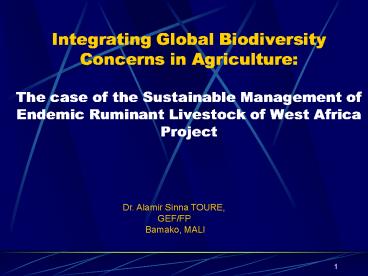Integrating Global Biodiversity Concerns in Agriculture: The case of the Sustainable Management of E - PowerPoint PPT Presentation
1 / 21
Title:
Integrating Global Biodiversity Concerns in Agriculture: The case of the Sustainable Management of E
Description:
... breeds (N'Dama cattle, Djallonk sheep and West African dwarf goat) representing ... preservation of biodiversity by protecting these endangered animal breeds, the ... – PowerPoint PPT presentation
Number of Views:34
Avg rating:3.0/5.0
Title: Integrating Global Biodiversity Concerns in Agriculture: The case of the Sustainable Management of E
1
Integrating Global Biodiversity Concerns in
Agriculture The case of the Sustainable
Management of Endemic Ruminant Livestock of West
Africa Project
Dr. Alamir Sinna TOURE, GEF/FP Bamako, MALI
2
PRESENTATION OUTLINE
- Project Background and Rationale
- Key Actors
- Outcomes and Achievements
- Constraints or Challenges Encountered
- Lessons Learnt
- Conclusion
3
Sustainable Management of Endemic Ruminant
Livestock of West Africa
- The project titled Sustainable Management of
Endemic Ruminant Livestock of West Africa is a
regional initiative undertaken in the areas of
agriculture and rural development
4
High population growth (2.4), rising income
among certain population segments, rapid
urbanisation, and changes in dietary habits have
led to an increase in the demand for animal
products. Poverty in these four countries
affects mainly the small agro-pastoralists
category.
5
- The project is aimed at preserving the
biodiversity of endemic ruminant livestock and
improving its productivity. - The sectoral objective is to contribute to
poverty alleviation and enhancement of food
security in West Africa.
6
Total Project Cost US 41.92 million
ITC
0.8
ILRI
0.4
COUNTRY
12
FAD LOAN
GEF
34
17
FAD GRANT
36
7
NDama Cattle Breed
8
Project sites in the four countries
9
Technical and Financial Partners
- BANK GROUP
- African Development Fund (FAD)
- Governments of Gambia, Guinea, Mali and Senegal
10
SCIENTIFIC PARTNERS
- ITC is an independent regional research
institution in the areas of crop farming and
livestock having its headquarters in Banjul. - ILRI, based in Nairobi, has made its mission to
enhance scientific knowledge and technical
capacities in order to increase the standard of
living of poor livestock farmers.
11
- These specialized subregional organizations will
work at country level with the support of the
following actors - Agricultural research institutes, veterinary
research laboratories, institutions or agencies
in charge of natural resource management,
environmental monitoring centres, academic
institutions, agencies and associations in charge
of livestock marketing. - COMMUNITIES IN THE FOUR PARTICIPATING COUNTRIES,
IN PARTICULAR AGRO-PASTORALISTS
12
OUTCOMES
- The project outcomes will be the following
- Increased production and productivity of endemic
livestock - Commercialisation of endemic livestock products
- Natural Resource Management at project pilot
sites - Legal and policy Framework for the sustainable
management of endemic livestock - Sub-regional system of information exchange for
the conservation of endemic livestock
13
LESSONS LEARNT
- The project fits within the framework of NEPAD
programmes for agricultural development and
environmental protection
14
- These genetic resources are resources shared by
the participating countries. The proposed project
will leverage synergies through regional
cooperation, pooling of resources and sharing of
the results and experiences in the areas of
genetic improvement and development of livestock
production systems.
15
Global genetic potential
- The project focuses on endemic livestock breeds
(NDama cattle, Djallonké sheep and West African
dwarf goat) representing a globally significant
genetic treasure trove resistance to such
diseases as trypanosomiasis, endoparasitosis and
dermatophilosis. These breeds are adapted to
ecological conditions prevailing in the sub-humid
zone.
16
- The project will provide an opportunity to take
into consideration livestock farming policies,
match animal population with available natural
resources, by way of a reduction in livestock
pressures and intensification of production
techniques.
17
In the 4 participating countries, the project
will contribute to
- The commitment to halve poverty by 2015 with the
framework of the Millennium Development Goals - Meeting strategic objectives in the areas of food
security and poverty reduction - Diversifying and strengthening the economic
agricultural base in rural areas, and job
creation.
18
- The project constitutes an application on the
countries legislation frameworks of various
legal international instruments (Global AGR
Strategy, CBD). - At subregional level, the project will help the
countries elaborate legislation to control
cross-breeding among various livestock races.
19
- While ensuring the preservation of biodiversity
by protecting these endangered animal breeds, the
project will remove obstacles to their
sustainable management and exploit the tremendous
potential of livestock breeding in the subhumid
zone of West Africa. - The promotion of endemic ruminant livestock
breeding will be conducted within
agro-pastoralists communities (in situ) with the
goal of making this activity more profitable
while simultaneously preserving these animals
biodiversity and maintaining their habitats.
20
CONSTRAINTS CHALLENGES ENCOUNTERED
- The main factors impinging upon project progress
include the following - Agriculture is essentially rain-fed and subject
to the vagaries of climate, - Inaccessibility of appropriate technologies,
- Limited access to primary health care in rural
areas. - Contributing factors
- Countries economic and social situation,
- Deteriorated conditions of rural roads and
infrastructure, which create obstacles to
marketing of production, in particular in rural
areas, - Unfavourable terms of exchange for most
agricultural commodities.
21
CONCLUSION
- Four West African countries have undertaken,
within a subregional framework, to participate in
the preservation of endemic ruminant livestock
biodiversity, remove obstacles to sustainable
livestock management and leverage the huge
potential of livestock breeding in the subhumid
zone of West Africa.































